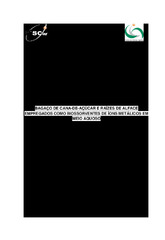| dc.contributor.author | Milani, Priscila Aparecida | |
| dc.date.accessioned | 2018-01-11T18:10:11Z | eng |
| dc.date.available | 2018-01-11T18:10:11Z | eng |
| dc.date.issued | 2017-06-05 | eng |
| dc.identifier.citation | MILANI, Priscila Aparecida. Bagaço de cana-de-açúcar e raízes de alface empregados como biossorventes de íons metálicos em meio aquoso. 2017. Dissertação (Mestrado em Agricultura e Ambiente) – Universidade Federal de São Carlos, Araras, 2017. Disponível em: https://repositorio.ufscar.br/handle/ufscar/9248. | * |
| dc.identifier.uri | https://repositorio.ufscar.br/handle/ufscar/9248 | por |
| dc.description.abstract | Sugarcane bagasse and hydroponic lettuce roots were used as biosorbents for Cu(II), Fe(II), Zn(II) and Mn(II) removal from mono and multielement solutions, as well as in lake water, at pH 5.5, in batch processes. These biomasses were studied in natura (lettuce roots, NLR, and sugarcane bagasse, NSB) and chemically modified with HNO3 (lettuce roots, MLR, and sugarcane bagasse, MSB). The results showed that higher adsorption efficiency was achieved with the modified biomass, with the exception of lettuce roots, which also presented similar efficiency when used in natura. The removal experimental quantities (qexp) in monoelement solution, calculated using the Langmuir isothermal model for Cu(II), Fe(II), Zn(II) and Mn(II) were respectively, 1.22, 1.08, 1.40 and 1.23 mg g-1 in NLR, and 1.69, 1.68, 1.09 and 1.48 mg g-1 in MLR and 0.58, 0.036, 0.40 e 0.24 mg g-1 in NSB, and 1.30, 1.41, 1.55 and 1.02 mg g-1 in MSB. The removal experimental quantities (qexp) in multielement solution containing Cu(II), Fe(II), Zn(II), and Mn(II) in multielement solution were 1.28, 1.41, 1.29 and 1.05 mg g-1 in NLR, and 1.30, 1.09, 1.72 e 1.64 mg g-1 in MLR, and 0.47, 0.58, 0.09 and 0.02 mg g-1 in NSB, and 1.30, 1.09, 1.06 and 1.62 mg g-1 in MSB, respectively. We used the isothermal models of Langmuir and Freundlich, however for multielement solutions the adsorption did not conform to the Freundlich isotherm. In the kinetic studies with modified biomasses, sorption was achieved in the first 5 minutes and reached equilibrium in 30 min. The O-H, C-O-C, C-C, C-H, and C=O groups were found in the characterization of the biomass sorption sites by Fourier transform infrared spectrometry (FTIR). In the determination of the biomass surface charges using blue methylene and red amaranth dyes, there was a predominance of negative charges. Modified biomasses were used in the adsorption of Cu(II), Fe(II), Zn(II), and Mn(II) in lake water, in which retention of 24.31, 14.50, 8.21, and 8.03 mg g-1 by MLR, and 13.15, 10.50, 5.14 and 6,10 mg g-1 by MSB was found, respectively. | eng |
| dc.description.sponsorship | Coordenação de Aperfeiçoamento de Pessoal de Nível Superior (CAPES) | por |
| dc.language.iso | por | por |
| dc.publisher | Universidade Federal de São Carlos | por |
| dc.rights.uri | Acesso aberto | por |
| dc.subject | Biossorção | por |
| dc.subject | Biomassa | por |
| dc.subject | Biorremediação | por |
| dc.subject | Descontaminação de águas | por |
| dc.subject | Biosorption | eng |
| dc.subject | Biomass | eng |
| dc.subject | Bioremediation | eng |
| dc.subject | Water decontamination | eng |
| dc.title | Bagaço de cana-de-açúcar e raízes de alface empregados como biossorventes de íons metálicos em meio aquoso | por |
| dc.title.alternative | Sugarcane bagasse and lettuce roots used as biosorbent of metallic ions in aqueous medium | eng |
| dc.type | Dissertação | por |
| dc.contributor.advisor1 | Carrilho, Elma Neide Vasconcelos Martins | |
| dc.contributor.advisor1Lattes | http://lattes.cnpq.br/5147872007117167 | por |
| dc.description.resumo | Biomassas de bagaço de cana-de-açúcar e raízes de alface hidropônica foram empregadas como biossorventes na remoção Cu(II), Fe(II), Zn(II) e Mn(II), em soluções mono e multielementares, assim como em água de lago, em pH 5,5, usando processos em batelada. Estas foram estudadas na forma in natura (raízes de alface, RAN, e bagaço de cana, BCN) e modificadas quimicamente com HNO3 (raízes de alface, RAM, e bagaço de cana, BCM). Os resultados mostraram que maior eficiência de sorção foi obtida com as biomassas modificadas, com exceção das raízes de alface, que também apresentaram semelhante eficiência mesmo in natura. As quantidades experimentais (qexp) de remoção em solução monoelementar Cu(II), Fe(II), Zn(II) e Mn(II) foram, respectivamente, 1,22, 1,08, 1,40 e 1,23 mg g-1 em RAN, e 1,69, 1,68, 1,09 e 1,48 mg g-1 em RAM e 0,58, 0,036, 0,40 e 0,24 mg g-1 em BCN, e 1,30, 1,41, 1,55 e 1,02 mg g-1 em BCM. As quantidades de remoção em solução multielementar contendo Cu(II), Fe(II), Zn(II) e Mn(II) foram 1,28, 1,41, 1,29 e 1,05 mg g-1 em RAN, e 1,30, 1,09, 1,72 e 1,64 mg g-1 em RAM, e 0,47, 0,58, 0,09 e 0,02 mg g-1 em BCN, e 1,30, 1,09, 1,06 e 1,62 mg g-1 para BCM, respectivamente. Foram utilizados os modelos isotérmicos de Langmuir e Freundlich, entretanto para soluções multielementares a sorção não se ajusta à isoterma de Freundlich. Nos estudos de cinética em biomassas modificadas, a sorção foi alcançada nos primeiros 5 minutos e atingiu o equilíbrio em 30 min. Na caracterização dos sítios de sorção das biomassas por espectrometria de infravermelho com transformada de Fourier (FTIR), observou-se a presença dos grupamentos O-H, C-O-C, C-C, C-H, e C=O. Na determinação da carga superficial das biomassas usando os corantes azul de metileno e vermelho amaranto houve predominância de cargas negativas. Biomassas modificadas foram empregadas na sorção de Cu(II), Fe(II), Zn(II) e Mn(II) em amostra de água de lago, e verificou-se retenção de 24,31, 14,50, 8,21 e 8,03 mg g-1, em RAM, e 13,15, 10,50, 5,14 e 6,10 mg g-1 em BCM, respectivamente. | por |
| dc.publisher.initials | UFSCar | por |
| dc.publisher.program | Programa de Pós-Graduação em Agricultura e Ambiente - PPGAA-Ar | por |
| dc.subject.cnpq | CIENCIAS AGRARIAS::AGRONOMIA | por |
| dc.ufscar.embargo | Online | por |
| dc.publisher.address | Câmpus Araras | por |
| dc.contributor.authorlattes | http://lattes.cnpq.br/2420667904233275 | por |
